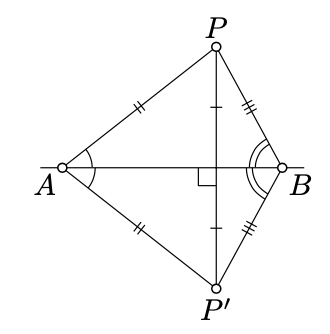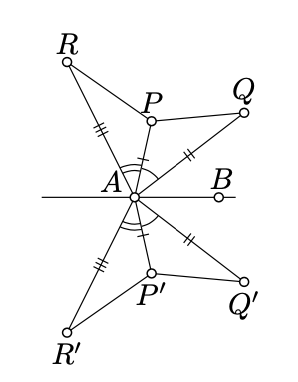5.4: Reflection across a line
( \newcommand{\kernel}{\mathrm{null}\,}\)
Assume the point P and the line (AB) are given. To find the reflection P′ of P across (AB), one drops a perpendicular from P onto (AB), and continues it to the same distance on the other side.
According to Theorem 5.3.1, P′ is uniquely determined by P.
Note that P=P′ if and only if P∈(AB).
Assume P′ is a reflection of the point P across (AB). Then AP′=AP and if A≠P, then ∡BAP′≡−∡BAP.
- Proof
-
Note that if P∈(AB), then P=P′. By Corollary 2.4.1, ∡BAP=0 or π. Hence the statement follows.

If P∉(AB), then P′≠P. By the construction of P′, the line (AB) is a perpendicular bisector of [PP′]. Therefore, according to Theorem 5.3.1, AP′=AP and BP′=BP. In particular, △ABP′≅△ABP. Therefore, ∡BAP′=±∡BAP.
Since P′≠P and AP′=AP, we get that ∡BAP′≠∡BAP. That is, we are let with the case
∡BAP′=−∡BAP.
The reflection across a line is a motion of the plane. Moreover, if △P′Q′R′ is the reflection of △PQR, then
∡Q′P′R′≡∡QPR.
- Proof
-
Note that the composition of two reflections across the same line is the identity map. In particular, any reflection is a bijection.

Fix a line (AB) and two points P and Q; denote their reflections across (AB) by P′ and Q′. Let us show that
P′Q′=PQ;
that is, the reflection is distance-preserving, Without loss of generality, we may assume that the points P and Q are distinct from A and B. By Proposition 5.4.1, we get that
∡BAP′≡−∡BAP,AP′=AP, ∡BAQ′≡−∡BAQ,AQ′=AQ.
It follows that
∡P′AQ′≡−∡PAQ.
By SAS, △P′AQ′≅△PAQ and 5.4.1 follows. Moreover, we also get that
∡AP′Q′≡±∡APQ.
From 5.4.2 and the theorem on the signs of angles of triangles (Theorem 3.3.1) we get
∡AP′Q′≡−∡APQ.
Repeating the same argument for a pair of points P and R, we get that
∡AP′R′≡−∡APR.
Subtracting 5.4.4 from 5.4.3, we get that
∡Q′P′R′≡−∡QPR.
Show that any motion of the plane can be presented as a composition of at most three reflections across lines.
- Hint
-
Choose an arbitrary nondegenerate triangle ABC. Suppose that △ˆAˆBˆC denotes its image after the motion.
If A≠ˆA, apply the reflection across the perpendicular bisector of [AˆA]. This reflection sends A to ˆA. Let B′ and C′ denote the reflections of B and C respectively.
If B≠ˆB, apply the reflection across the perpendicular bisector of [B′ˆB]. This reflection sends B′ to ˆB. Note that ˆAˆB=ˆAB′; that is, ˆA lies on the perpendicular bisector. Therefore, ˆA reflects to itself. Suppose that C″ denotes the reflection of C'.
Finally, if C'' \ne \hat{C}, apply the reflection across (\hat{A}\hat{B}). Note that \hat{A}\hat{C} = \hat{A} C'' and \hat{B}\hat{C} = \hat{B} C''; that is, (AB) is the perpendicular bisector of [C''\hat{C}]. Therefore, this reflection sends C'' to \hat{C}.
Apply Exercise 4.4.3 to show that the composition of the constructed reflections coincides with the given motion.
The motions of plan can be divided into two types, direct and indirect. The motion f is direct if
\measuredangle Q'P'R' = \measuredangle QPR
for any \triangle PQR and P' = f(P), Q' = f(Q) and R' = f(R); if instead we have
\measuredangle Q'P'R' \equiv -\measuredangle QPR
for any \triangle PQR, then the motion f is called indirect.
Indeed, by Corollary \PageIndex{1}, any reflection is an indirect motion. Applying the exercise above, any motion is a composition of reflections. If the number of reflections is odd then the composition indirect; if the number is even, then the motion is direct.
Let X and Y be the reflections of P across the lines (AB) and (BC) respectively. Show that
\measuredangle XBY \equiv 2 \cdot \measuredangle ABC.
- Answer
-
Note that \measuredangle XBA = \measuredangle ABP, \measuredangle PBC = \measuredangle CBY. Therefore,
\measuredangle XBY \equiv \measuredangle XBP + \measuredangle PBY \equiv 2 \cdot (\measuredangle ABP + \measuredangle PBC) \equiv 2 \cdot \measuredangle ABC.


